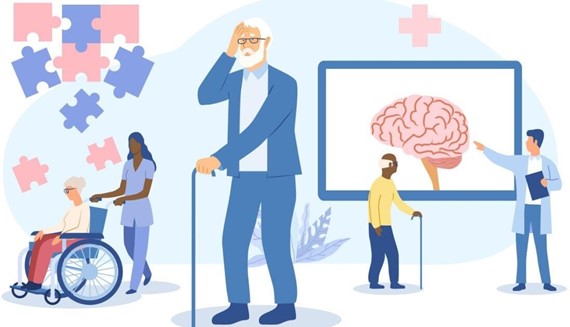An older adult in the middle and late stages of Alzheimer's forgets where the bathroom is and has episodes of incontinence. Which intervention should the nurse suggest to the client's family?
Label the bathroom door.
Take the older adult to the bathroom hourly.
Place the older adult in disposable adult briefs.
Limit the intake of oral fluids to 1000 mL/day.
The Correct Answer is A
A. Labeling the bathroom door can provide a visual cue to help the older adult locate the bathroom, which may reduce episodes of incontinence.

B. Taking the older adult to the bathroom hourly is a good strategy, but it may not always be feasible or effective in preventing accidents.
C. Using disposable adult briefs may be necessary at times, but it should not be the first line intervention.
D. Limiting oral fluids to 1000 mL/day may lead to dehydration and is not an appropriate intervention for addressing incontinence.
Nursing Test Bank
Naxlex Comprehensive Predictor Exams
Related Questions
Correct Answer is A
Explanation
A. "This therapy helps you learn to think more positively, and thereby reduce depressive
thoughts and symptoms." Cognitive behavioral therapy (CBT) aims to identify and challenge negative thought patterns and replace them with more positive and realistic thinking, which can help alleviate symptoms of depression.
B. "In this therapy, you will explore past events and analyze how these events have affected your behavior and thoughts." This description is more characteristic of psychodynamic therapy, not cognitive behavioral therapy.
C. "This type of therapy focuses on how you use defense mechanisms to feel more comfortable and content." This description aligns more with psychodynamic therapy, not cognitive behavioral therapy.
D. "The purpose of this therapy is to determine how to get psychological needs met through
interpersonal relationships." This statement does not accurately describe cognitive behavioral
therapy, which primarily focuses on identifying and changing maladaptive thought patterns and behaviors.
Correct Answer is A
Explanation
A. "As depression lifts, physical energy becomes available to carry out suicide." This statement highlights a critical consideration in the care of severely depressed clients. When a client's depression starts to improve due to antidepressant therapy, there may be a period where they have increased energy but have not yet gained full relief from their depressive thoughts. This can potentially increase the risk of carrying out suicidal thoughts or plans.
B. "Suicide may be precipitated by a variety of internal and external events." While this statement is true, it does not specifically address the importance of monitoring a client during antidepressant therapy.
C. "Suicidal clients have difficulty using social supports." This statement acknowledges a potential challenge for clients who are experiencing suicidal thoughts, but it does not directly relate to the need for close monitoring during antidepressant therapy.
D. "Suicide is an impulsive act that has no warning." This statement is not entirely accurate. While some suicides can be impulsive, many individuals give warning signs or exhibit changes in behavior before attempting suicide.
Whether you are a student looking to ace your exams or a practicing nurse seeking to enhance your expertise , our nursing education contents will empower you with the confidence and competence to make a difference in the lives of patients and become a respected leader in the healthcare field.
Visit Naxlex, invest in your future and unlock endless possibilities with our unparalleled nursing education contents today
Report Wrong Answer on the Current Question
Do you disagree with the answer? If yes, what is your expected answer? Explain.
Kindly be descriptive with the issue you are facing.
